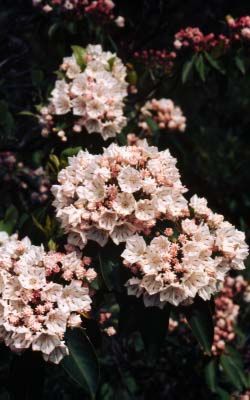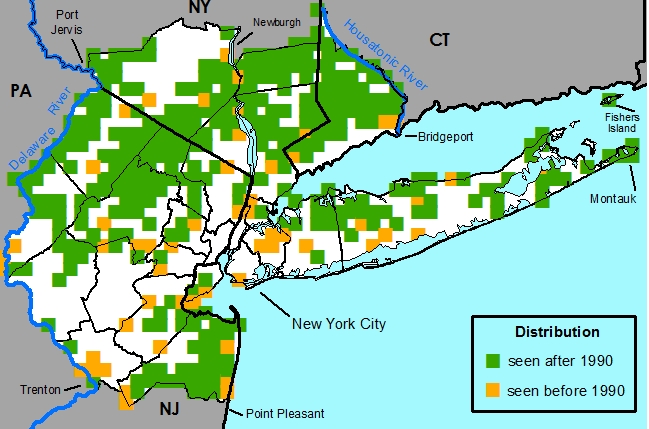Kalmia latifolia L. - Mountain Laurel

Mountain Laurel
Photo © Peter Nelson, 1972, taken in the New Jersey pine barrens.
Common Names
Mountain LaurelField Identification
An evergreen shrub with alternate, elliptic leaves and pink to white bell-shaped flowers.Medicinal uses
Disclaimer: The information provided here is for reference and historical use. We do not recommend nor do we condone the use of this species for medicinal purposes without first consulting a physician.The leaves are considered cardiac, sedative, alterative, and astringent. They have been recommended for blood disorders, in overcoming obstinate chronic irritation of mucous membranes and in active hemorrhage, diarrhea, and dysentery.
Other uses
(Britton, 1913) (Buttrick, 1924) (Holmes, 1956) (Kurmes, 1961) (Uphof, 1968)The wood is close-grained, hard, and brittle. It is used for rustic furniture, handles, ternary weaver's shuttles, pulleys, spoons, trowels, and fuel. The roots are used as a substitute for making imitation brierwood pipes. The leaves are gathered at Christmas time, used to decorate buildings, and sold in markets.
Stories
First recorded in Henry Hudson's log of his trip to Cape Cod in 1609.
Poisonous properties
Disclaimer: The information provided here is for reference and historical use. If you believe you have been poisoned, please contact the Poison Control Office near you (look for the number in the front of the phone book).
(Forbes, 1931) (Hardin & Arena, 1974) (Jaynes,1975) (Kurmes, 1961) (Lewis & ElvinLewis, 1977) (Uphof, 1968)
All parts of the plant, including pollen, contain andromedotoxin, a toxic diterpene causing slow pulse, lowering of blood pressure, lack of coordination, convulsions, progressive paralysis, and death. Arbutin, a glycoside of hydroquinone, is also present and indicated in poisoning. Poisonous honey is produced by bees visiting the flowers. Children have been poisoned by sucking on flowers and making a decoction from leaves. The Delaware Indians used mountain laurel to commit suicide. The species is also poisonous to deer and sheep, though deer seldom eat enough for it to be a problem. In one report a dog died after eating the entrails of a deer that had eaten mountain laurel.
Nomenclature
*Kalmia latifolia L., Sp. Pl. 1: 391. 1753. *Chamaedaphne latifolia (L.) Kuntze, Revis. Gen. Pl. 2: 388. 1891. TYPE: Location and collector unknown (Lectotype: LINN 560.1, specimen at the top right (IDC 177, f. 315, r. 2. c. 5)), selected by (Ebinger, 1974), see also (Southall & Hardin, 1974), (Reveal et al., 1987). Note that Reveal in (Jarvis et al., 1993) lectotypified this species based on Plukenet, Phytographia: t. 379, f. 6. 1705.*Kalmia latifolia var. alba Raf., Med. Fl. 2: 17. 1830. *Kalmia latifolia var. alba (Raf.) Bosse, Vollst. Handb. Bl.-Gärtn., ed. 2, 2: 348. 1841. *Kalmia latifolia f. alba (Raf.) Rehder, Rhodora 12: 2. 1910. TYPE: Type not cited.
*Kalmia latifolia var. maeulata Raf., Med. Fl. 2: 17. 1830. TYPE: Type not cited.
*Kalmia latifolia var. ternata Raf., Med. Fl. 2: 17. 1830. TYPE: Type not cited.
*Kalmia latifolia var. acuminata Raf., Med. Fl. 2: 17. 1830, nom. inval. (Art. 32.1c). TYPE: Type not cited.
*Kalmia latifolia var. ovatifolia Raf., Med. Fl. 2: 17. 1830, nom. inval. (Art. 32.1c). TYPE: Type not cited.
*Kalmia latifolia var. arbora Raf., Med. Fl. 2: 17. 1830, nom. inval. (Art. 32.1c). TYPE: Type not cited.
*Kalmia latifolia var. salicifolia J. Forbes, Hort. Woburn. 93. 1833. TYPE: Type not cited. [willow leaves]
*Kalmia nitida J. Forbes, Hort. Woburn. 93. 1833. TYPE: Type not cited, "unknown, probably a living plant" (Ebinger, 1974). [shiny leaves]
*Kalmia latifolia var. myrtifolia Bosse, Vollst. Handb. Bl.-Gärtn., ed. 2, 2: 348. 1841. *Kalmia latifolia var. nana Lavalée, Inum. Arbres. 139. 1877, nom. inval. (Art. 32.1c). *Kalmia myrtifolia (Bosse) André, Rev. Hort. 55: 10. 1883. *Kalmia latifolia f. myrtifolia (Bosse) K. Koch, Dendrologie 2(1): 153. 1872. *Kalmia latifolia var. nana or var. minor Mouill., Traité Arbr. Arbrisse 2: 1027. 1897, nom. illeg. (Art. 52.1). TYPE: Type not cited, "unknown, probably a living plant" (Ebinger, 1974). [miniature, compact and slow-growing; probably a cultivar]
*Kalmia latifolia var. coronata A. Gray, Amer. Naturalist 2: 323-324. 1868. TYPE: Type not cited, [original plant from] United States. Massachusetts: woods near Framingham, James Parker (GH); grafted by Charles J. Parker. [white corolla with broad crown of dark crimson which occupies the inside of the cup]
*Kalmia latifolia f. rubra Sweet ex K. Koch., Dendrologie 2(1): 152. 1872. *Kalmia latifolia var. rubra (Sweet ex K. Koch) Rehder in Bailey, Cycl. Amer. Hort. 2: 854. 1900. TYPE: Type not cited.
*Kalmia lucida K. Koch, Dendrologie 2(1): 152. 1872, nom. inval. (Art. 34.1c). TYPE: Type not cited.
*Kalmia latifolia f. minor K. Koch., Dendrologie 2(1): 153. 1872. TYPE: Type not cited, "unknown, probably a living plant" (Ebinger, 1974). [miniature, compact and slow-growing; probably a cultivar]
*Kalmia latifolia var. pavarti André, Rev. Hort. 60: 540-541, t. opp. p. 540. 1888. TYPE: Type not cited, [le coloris beaucoup plus vif, plus décidément rouge de ses fleurs].
*Kalmia latifolia var. polypetala G. Nicholson, Hand-List Trees and Shrubs 2: 49. 1896. *Kalmia latifolia f. polypetala (G. Nicholson) Beissn. et al., Handb. Landholzben. 386. 1903. TYPE: Type not cited. [corolla deeply divided into 5 narrow to broad petals]
*Kalmia latifolia var. monstruosa Mouill., Traité Arbr. Arbrisse 2: 1027. 1897. TYPE: Type not cited, "unknown, probably a living plant" (Ebinger, 1974). [polypetalous]
¤Kalmia latifolia var. fuscata Rehder, Müller's Deutsche Gärtn-Zeitung 18: 578. 1903. *Kalmia latifolia f. fuscata (Rehder) Rehder, Rhodora 12: 2. 1910. TYPE: United States. New York: Canaan Four Corners, Dr. Childs (Holotype: GH). [white to pink flowers with brownish purple or cinnamon band]
¤Kalmia latifolia var. obtusata Rehder, Müller's Deutsche Gärtn-Zeitung 18: 577. 1903. *Kalmia latifolia f. obtusata (Rehder) Rehder, Rhodora 12: 2. 1910. TYPE: United States. Connecticut: near Pomfret, Bowditch s.n. (Holotype: GH?).
*Kalmia latifolia f. polypetala Rehder, Rhodora 12: 1. 1910, nom. illeg. (Art. 53.1). TYPE: United States. Massachusetts: near Deerfield, Miss M. Bryant (Holotype: GH). [corolla deeply divided into 5 narrow to broad petals]
*Kalmia latifolia var. laevipes Fernald, Rhodora 42: 53. 1940. TYPE: United States. Virginia: Norfolk Co., dry woods of a "hammock", Great Dismal Swamp, west of Yadkin, Fernald & Long 11101 (Holotype: GH; Isotype: PH). [glandular or scarcely glandular pedicels]
*Kalmia latifolia f. angustata Rehder, J. Arnold Arbor. 26: 481. 1945. TYPE: United States. New Jersey: Cape May Co., Dennis Township, H.A.Scribner s.n. (Holotype: GH). [very narrow leaves]
Description
HABIT perennial, evergreen, phanerophyte or chamaephyte, shrubs, autotrophic, monoclinous, with adventitious roots and with fibrous roots, 2-3 m tall, not modified or with rhizomes.STEMS erect, round, not winged, "regular". Prickles absent. Bark striate, not exfoliating, gray. Branches ascending, gray or orange, round, not winged, 3.5-4 mm in diam. Twigs orange or yellowish orange, not odoriferous, round, 2-3 mm in diam., smooth, glabrous or hairs short and unbranched, erect, unicellular or multicellular, uniseriate or multiseriate, white, moderately dense, throughout, glabrescent, glands present, glands at apex of hairs, yellow or orange-yellow. Pith present, light orange-yellow, round, continuous, nodal diaphragm absent. Thorns absent. Aerial roots absent. Sap translucent. Resin absent.
LEAVES alternate or subopposite or opposite or whorled (alternate but appearing otherwise because the leaves are so close together), 1-3 per node, crowded toward stem apex, divergent from stem, simple. Stipules absent. Leaves petiolate, petiole "typical", 0.4-1.9 cm long, hairs short and unbranched, erect, unicellular or multicellular, uniseriate or multiseriate, moderately dense, throughout, not glabrescent, glands present, glands at apex of hairs. Leaf: abaxial surface greenish yellow, adaxial surface dark green, blades narrowly elliptic or elliptic, plane, symmetric, 4.1-9.8 cm long, 1.3-3.9 cm wide, coriaceous, base cuneate, margin entire, apex acuminate, abaxial surface hairs short and unbranched, erect, multicellular, multiseriate, white, moderately dense, throughout, glabrescent, glands present, glands at apex of hairs, dark orange-red, adaxial surface glabrous, without glands. Eucamptodromous venation, veins 7-9. Leaf lobes absent. Spines absent. Tendrils absent.
INFLORESCENCES monomorphic, regular or, if dimorphic, female inflorescence simple, panicle, terminal. Peduncle present, 0.4-0.7 cm long. Rachis present, 1-2.5 cm long, with bracts. Bracts sessile, blades: abaxial surface green or dark red, adaxial surface green or dark red, ovate or lanceolate, curved, 1.6-3 mm long, 1-1.7 mm wide, base truncate, margin ciliate, apex acute, abaxial surface hairs short and unbranched, abaxial hairs erect, unicellular, uniseriate, white, sparse to dense, throughout, not glabrescent, glands present, glands at apex of hairs, orange-yellow, adaxial surface glabrous, without glands. Pedicel 1.7-2.9 mm long, hairs long and unbranched, hairs spreading, multicellular, multiseriate, white or orange, moderately dense, throughout, not glabrescent, glands present, glands at apex of hairs, orange. Bracteoles 2, sessile, at base of pedicel, not connate, bracteoles: abaxial surface green or dark red, bracteole: adaxial surface green or dark red, ovate, curved, 1.2-1.8 mm long, 0.7-0.8 mm wide, base truncate, margin ciliate, apex acute. Cupules absent.
FLOWERS serotinous, formed on long shoots, monomorphic, with sepals and petals readily distinguishable from one another, bisexual. Perfect or female flowers red or white, 5-merous, 0.8-1.2 mm long, 1.7-2.3 mm wide, 10-16 flowers per inflorescence, perianth of two whorls. Calyx present, actinomorphic, campanulate, of free sepals, persistent, abaxial and adaxial surfaces the same color, yellowish green, 2.4-2.6 mm long, 2.2-3 mm wide. Sepals or sepal lobes 5, narrowly elliptic, 1.7-2.4 mm long, 0.8-1 mm wide, base truncate, margin ciliate (glandular ciliate), apex acute, abaxial surface hairs short and unbranched, erect, multicellular, multiseriate, white, moderately dense, throughout, glabrescent (?), glands present, glands at apex of hairs, orange, adaxial surface glabrous, without glands. Epicalyx absent. Corolla present, actinomorphic, acetabuliform, of fused petals, deciduous, abaxial and adaxial surfaces the same color, red or white, 1.4-1.5 mm long, 2-2.4 mm wide. Petals or petal lobes 5, "normal", shallowly triangular, 1-2 mm long, 2-3 mm wide, base truncate, margin entire, apex acute, abaxial surface glabrous, without glands, adaxial surface glabrous, without glands. Gynoecium syncarpous. Carpels 5. Stigmas 1, lobed, flat, 5-lobed. Styles not persistent, 1, 1.2-1.6 mm long. Ovary superior, 1.6-1.8 mm long, 2-2.2 mm wide, nectiferous disk present. Locules 5. Placentation axile. Androecium obdiplostemonous. Stamens 10, 9.7-11.4 mm long. In pockets on the corolla, Anthers oblong, opening along the long axis, bithecal, yellowish orange, glabrous. Filaments free, straight, red or white, hairs short and unbranched, erect, unicellular, uniseriate. Staminodes absent.
FRUITS septicidal capsule, reddish orange, depressed globose, 2.5-3.5 mm long, 3.6-4.7 mm wide, hairs long and unbranched, erect, multicellular, multiseriate, orange, moderately dense, throughout, glabrescent, glands present, glands at apex of hairs, orange.
SEEDS many, yellowish orange, oblong, 0.6-0.8 mm long, 0.2-0.3 mm wide, wingless, not tailed, lineate.
Habitat
(Buttrick, 1924) (Kurmes, 1961) (Monk et al., 1985) (Wilson & O'Keefe, 1983) (Wherry, 1920)
Sand and peaty swamps and dry wooded areas (dry sandy slopes, deciduous woods, open rock woods, pine woods, shaded knoll, scrub land, wooded limestone hill, dry open-wooded rocky crest, gravelly hillside). It grows in deep sands, swamps, and rocky hillsides. Associated with drier exposed slopes and ridges than Rhododendron maximum. It does not do well after clearing; it will not recolonize an area rapidly. Dry upland peat and wet sphagnum soil with a pH of 4.5-5.5. In moist but not excessively wet areas it attains its greatest size.
Rarity Status
Heritage global rank -- G5Connecticut -- not listed
New Jersey -- not listed
New York -- not listed
Species Biology
FloweringMay [week 3] - July [week 1].
Pollination
(Jaynes, 1968) (Jaynes, 1988) (Rathcke & Real, 1993)Melittophily -- Bumble bees.
Autogamy -- Autogamy is present in some populations but not others. Only weakly self-compatible.
Fruiting
June [week 3] - Oct [week 4] (April [week 3]).
Dispersal
(Kurmes, 1961)Anemochory -- Rarely carried long distances.
Germination
(Buttrick, 1924) (Flemer, 1949) (Jaynes, 1975) (Jaynes, 1982) (Jaynes, 1988) (Kurmes, 1961)Germinable -- Fresh seeds need no special treatment. Natural seedlings are most frequently found on beds of immature, discontinuous or low mosses.
Light required.
Prechilling required(?) -- Cold stratification for 8 weeks will increase germination percentage. The presence of endophytic fungal culture improves survival. "Germination of seed collected in April and June from plants in the field was very poor" (Kurmes, 1961).